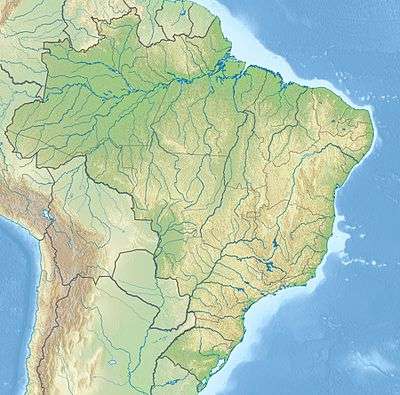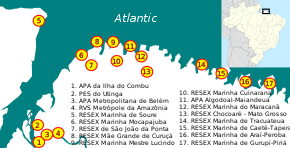Cuinarana Marine Extractive Reserve
| Cuinarana Marine Extractive Reserve | |
|---|---|
| Reserva Extrativista Marinha Cuinarana | |
|
IUCN category VI (protected area with sustainable use of natural resources) | |
 | |
| Nearest city | Magalhães Barata, Pará |
| Coordinates | 0°47′10″S 47°42′03″W / 0.786230°S 47.700929°WCoordinates: 0°47′10″S 47°42′03″W / 0.786230°S 47.700929°W |
| Area | 11,037 hectares (27,270 acres) |
| Designation | Extractive reserve |
| Created | 10 October 2014 |
| Administrator | Chico Mendes Institute for Biodiversity Conservation |
The Cuinarana Marine Extractive Reserve (Portuguese: Reserva Extrativista Marinha Cuinarana) is a coastal marine extractive reserve in the state of Pará, Brazil.
Location

10. Cuinarana Marine Extractive Reserve
The Cuinarana Marine Extractive Reserve is in the municipality of Magalhães Barata, Pará. It has an area of 11,037 hectares (27,270 acres).[1] The reserve protects the mangroves between the east bank of the Marapanim River and the west bank of the Cuinarana River. The Mestre Lucindo Marine Extractive Reserve lies to the west and the Maracanã Marine Extractive Reserve lies to the east.[2]
History
The Cuinarana Marine Extractive Reserve was created by federal decree on 10 October 2014.[3] The reserve is one of three created by president Dilma Rousseff thirteen days before the 2014 presidential elections. The other two are the Mocapajuba and Mestre Lucindo marine extractive reserves, both also in Pará. The Araí-Peroba Marine Extractive Reserve was expanded by 50,500 hectares (125,000 acres).[4]
The reserve is administered by the Chico Mendes Institute for Biodiversity Conservation (ICMBio).[5] It is classed as IUCN protected area category VI (protected area with sustainable use of natural resources). The objective is to conserve the biodiversity of the ecosystems of mangroves, salt marshes, dunes, wetlands, floodplains, rivers, estuaries and islands; and to protect the livelihoods and culture of the traditional extractive population, and ensure the sustainable use of natural resources of the unit.[6]
Notes
- ↑ RESEX Marinha Cuinarana – ISA, Informações gerais.
- ↑ RESEX Marinha Cuinarana – ISA, Informações gerais (mapa).
- ↑ RESEX Marinha Cuinarana – ISA, Historico Juridico.
- ↑ Daniele Bragança 2014.
- ↑ Resex Marinha Cuinarana – ICMBio.
- ↑ Unidade de Conservação ... MMA.
Sources
- Daniele Bragança (13 October 2014), "Em plena campanha, Dilma cria novas UCs na Amazônia", O Eco, retrieved 2016-09-10
- Resex Marinha Cuinarana (in Portuguese), ICMBio: Chico Mendes Institute for Biodiversity Conservation, retrieved 2016-09-11
- RESEX Marinha Cuinarana (in Portuguese), ISA: Instituto Socioambiental, retrieved 2016-09-11
- Unidade de Conservação: Reserva Extrativista Marinha Cuinarana (in Portuguese), MMA: Ministério do Meio Ambiente, retrieved 2016-09-11